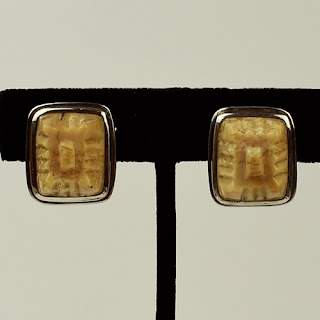Patania was a Sicilian jeweler, intensively trained in European styles and techniques. In 1927, while working in New York City, he contracted TB and was sent to the clean fresh air of Santa Fe to recuperate--and never left. The culture and history of the Southwest proved irresistible to him, and he opened up his own shop, the Thunderbird Shop, in Santa Fe.
Patania's work was a wonderful synthesis of Indian materials (silver and turquoise, mostly) and forms with a European emphasis on quality and good design. His pieces are instantly recognizable by their balance and fine finishes. Note the restrained use of stamping and applique in the above bracelet, a far cry from the heavily stamped Indian pieces of the time. Stones were always carefully set, and of very high quality.
Patania did not limit himself to the typical forms of the southwest, as the necklace above shows. And, most importantly, he was very generous with his time and skills with the Indian and Hispanic silversmiths who worked in the Thunderbird Shops (he opened a second one in Tucson in the 1950s.) Hispanic artists such as Alberto Contreras and Carlos Diaz, Navajos such as Jimmie Herald Sr., and most importantly, Pueblo smiths such as Lewis Lomay and Julian Lovato all developed their own distinctive skills and styles under the tutelage of Patania. It is no exaggeration to say that the emphasis on clean design and high quality in today's Indian silversmithing is as much due to the influence of Patania as anything else.
The concho belt above is by Joe H. Quintana, a Cochiti smith who worked in Santa Fe at the same time as Patania, though never in Patania's shop. The buckle and conchos are both typically Patania, adopted by a smith who knew his work well and used it to great effect.
Patania died in 1964, but his pieces remain masterworks of Southwest style. And his influence, through both his designs and his students, continues strongly to this day.
The second non-Indian is Eveli Sabatie, who also came to the Southwest through a combination of luck and happenstance. Raised in Morocco and educated in Paris, Sabatie came to San Francisco in the late 1960s and met a Hopi man who told her she should visit the Mesas. She did, and a chance meeting at a laundromat in 1968 introduced her to Charles Loloma, who would become her partner in both romance and art. Loloma taught her the basics of making jewelry, and she introduced him to a more sculptural style of art.
Eveli's work has African undertones, a natural considering her background. It also makes use of a great variety of materials not traditionally seen in Southwest jewelry. Asymmetry and anthropomorphic features are also hallmarks of her work, and this influenced Loloma's work as well.
Note the carved mermaid in the necklace above.
And the reverse of the same necklace.
Eveli and Loloma were together from 1968 until 1972, during which time Loloma's inlay designs underwent a drastic shift from his exposure to Eveli. She continued to work in jewelry for the net 20 years, continuing to produce unique and wonderful things in a variety of forms. Through her association with Loloma, her influence on inlay and jewelry design in the Southwest is huge, and her work is worthy of inclusion in any collection of Indian jewelry.






What'S New In Old American Indian Art: Two Honorary Indians In Southwest Jewelry >>>>> Download Now
ReplyDelete>>>>> Download Full
What'S New In Old American Indian Art: Two Honorary Indians In Southwest Jewelry >>>>> Download LINK
>>>>> Download Now
What'S New In Old American Indian Art: Two Honorary Indians In Southwest Jewelry >>>>> Download Full
>>>>> Download LINK 6h